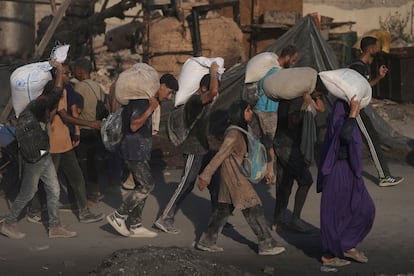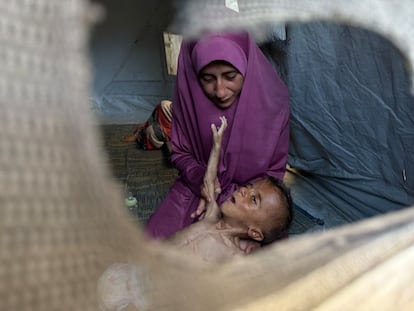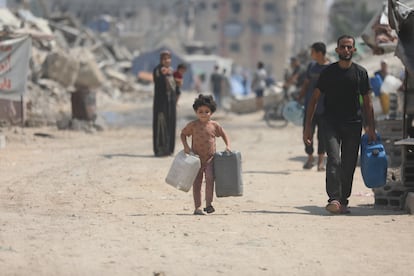Gaza is wasting away, exhausted by hunger. Samer Abuzerr, a professor of public health at Khan Younis University of Science and Technology, says the lack of food is already more painful than the bombs. “Everything is catastrophic, but hunger, slow, silent, and preventable, is the most painful. Bombs kill instantly, but hunger kills in prolonged agony, especially children,” explains this researcher from a shelter south of the Strip. He is one of three signatories of a letter to the prestigious medical journal The Lancet, denouncing that Israel is using famine as a “weapon of war” in Gaza. The situation is unsustainable, he says: “Watching a mother try to feed her child with crushed grains of rice soaked in contaminated water is indescribably painful.”
The consequences for the health and lives of the population will be devastating, he warns. For the Gazans of today and tomorrow. “Today's children risk becoming a lost generation, physically and mentally affected by trauma and hunger,” Abuzerr laments in an email conversation. Scientific studies on the impact of other famines, such as those that occurred during World War II, have shown that the damage caused by such food deprivation can leave metabolic and cardiovascular aftereffects, even in the descendants of those who have suffered these episodes of starvation.
According to Palestinian authorities, the number of deaths from starvation is around 50 this month alone (more than 100 since the start of the war), and if nothing changes, experts on the ground warn, many more will come.
The entire population of the Strip, 2.1 million people, are in a situation of acute food insecurity, and if everything remains the same, by September half a million people will be in a catastrophic situation of extreme hunger, the most serious phase, according to the Integrated Phase Classification (IPC), the internationally recognized index for gauging the food situation. “Being in that phase five, catastrophic, means they are facing extreme hunger and a real risk of death from starvation if immediate intervention is not taken,” explains Cristina Izquierdo, Nutrition Coordinator for Action Against Hunger's Emergency Team. But the rest of the population isn't much better off either, she warns: “A phase three or four, that is, crisis or emergency, means that many families are forced to skip meals, reduce portions, or sell what little they have to try to get cash to invest in food.”

Izquierdo, who spent several months in Gaza last year, says that hunger “is just as cruel” as the bombs: “It strips you day by day, it takes away your strength, your hope, your dignity… I don't know what it must be like to see your children crying without being able to comfort them, without having anything to offer them, and for the pain of an empty stomach to become a daily occurrence. During the bombings, at least, you can run to a shelter, but where do you run when there's nothing to eat?” he reflects. Hunger is “silent,” he continues, but just as murderous: “Right now, it's the most destructive enemy because it affects everyone, all the time, without respite.”
The experts consulted are urging us to waste no more time: people are dying of hunger; and those who don't die today, they warn, could suffer the consequences of this famine for life.
A cascade of organic failures
The human body is designed to tolerate periods of fasting, but for a limited time, explains Carol Lorencio, coordinator of the Metabolism and Nutrition working group of the Spanish Society of Intensive Care Medicine, Critical Care, and Coronary Care Units (Semicyuc):"In these situations, our body adapts to ensure that our cells receive the necessary energy." The problem is that, when this lack of food continues over time, the body no longer has anywhere to obtain glucose—the main fuel for cells—or other substrates that allow it to function, and it begins to accumulate, in a kind of cascade, organ failures that ultimately cause death.
Lorencio explains that, in the first few hours without food, the body relies on its glucose stores, for example in the liver and muscles, to function."But these reserves are finite; they are depleted in 24 to 36 hours, and if we continue without food, we will have to resort to a secondary mechanism, which is to synthesize glucose through other substrates, such as amino acids," explains the intensivist.
This strategy, however, also has its limits, and on the third or fourth day, when there is no more glucose or any way to generate it, the body has to turn to other energy substrates, such as ketone bodies, which are created by breaking down fat."But in this whole process, what happens is that we are consuming ourselves. We are degrading our own substrate to obtain energy," explains Lorencio. And that has consequences for health.

He gives some examples:"If you break down muscle, the heart, which is a muscle, will stop functioning properly. The brain, which only consumes glucose, can fall into lethargy or coma when there's no glucose. The liver, due to stress, can also malfunction." Thus, he points out, starvation lasting more than four or five days can lead to"multiple organ failure." And if dehydration is added to that,"it can lead to death within days."
There are no exact figures on how long an organism can go without food, Lorencio adds, as it depends on factors such as whether starvation is accompanied by dehydration or the person's previous physical condition. But the consequences of this entire process are devastating, he insists.
Hunger hurts
Along the way, the body shrinks and also hurts. Because hunger hurts. Physically and mentally: “It's a situation of pain and discomfort. When the hypothalamus stimulates hunger and thirst, there is discomfort, restlessness, and unease,” explains Lorencio.
On the sands of Gaza, the entire process of starvation to death that the world is witnessing firsthand is experienced with “overwhelming hopelessness,” says Abuzzer, who lives there with his wife and four children. “People say, ‘We no longer fear death, we fear surviving another day without food.’ Parents skip meals to feed their children. Children beg for food in the streets or eat leaves, fodder, or flour mixed with seawater… The most common emotions are despair and abandonment: the feeling that the world has abandoned them,” explains the Palestinian researcher.
People are doing what they can to survive. From harvesting wild herbs, grass, animal feed, or expired canned food, Abuzzer says, to digging wells in search of water—often contaminated—or burning plastic for cooking, even though it's toxic. It's about killing hunger before hunger kills them. “Informal support networks—neighbors sharing leftovers—are what keep many alive. A black market has emerged, but prices are exorbitant. A kilo of flour can cost up to $50, something unaffordable for most,” he emphasizes.
The situation is “heartbreaking,” Izquierdo agrees: “I remember some mothers trying to put their children to bed early so they wouldn’t feel hungry. It’s a forced and exhausting form of survival.”
Visible scars: pneumonia, diarrhea, scabies
The consequences of this lack of food are already leaving visible scars beyond the deaths. Izquierdo explains that they are especially serious in children, a group where an increase in acute malnutrition has already been observed:"They lose weight rapidly, they weaken, their immune system deteriorates, and this makes them more vulnerable to common illnesses, such as pneumonia or diarrhea." A report by the NGO Oxfam Intermón indicates that diseases transmitted by unsafe water have increased by nearly 150% in three months."Outbreaks of watery diarrhea, jaundice, scabies, hepatitis A, typhoid fever, and measles are rampant," attests Abuzzer, an expert in health systems in crisis situations and infectious disease prevention.
Hunger and disease are interconnected. “A vicious cycle,” says the Palestinian researcher, since malnutrition weakens the immune system, making people more vulnerable to infections. “And if malnutrition becomes chronic in children, they stop growing properly, and this affects not only their height but also their cognitive development,” adds Izquierdo.
In adults, the body also weakens, losing muscle mass and suffering from chronic fatigue, anemia, and metabolic disorders. This is in addition to the psychological and emotional impact of starvation. “Constant hunger causes anxiety, irritability, and depression,” the activist recalls. Experts place particular focus on the impact on pregnant women: malnutrition can lead to complications during pregnancy, premature births, low-birth-weight babies, and increased mortality. Furthermore, the offspring of women who are currently malnourished can suffer from alterations in brain development with lasting consequences for their health.
An inheritance of poor health
That's the legacy for the future."Malnutrition in early childhood leads to lifelong cognitive impairment, lower academic performance, and chronic diseases. Epigenetic studies of the Dutch famine [during World War II] showed that the effects of starvation persisted in offspring decades later," Abuzzer recalls. Children of pregnant women at that time had a higher risk of obesity, diabetes, and coronary heart disease, and some of their grandchildren, in 2008, even bore traces of those scars in the form of altered gene function.

Other research on the impact of the siege of Leningrad in the early 1940s revealed that those exposed to famine as adolescents were at greater risk of developing cardiovascular diseases, such as heart attacks and strokes. “The impact of malnutrition we see today in Gaza doesn't stop with this generation: hunger left untreated today can become a cycle of poverty, disease, and inequality that is inherited,” warns Izquierdo.
The bureaucratic paradox
According to the ICF, famine is declared when 20% of families cannot meet their minimum food needs, 30% of children under five are severely malnourished, and at least two deaths per day per 10,000 inhabitants are due to famine. This is difficult to measure given the devastation in Gaza and the blockage of access for humanitarian personnel.
“The absence of a formal declaration cannot be an excuse for inaction. And reality demands an immediate response, not a bureaucratic one,” Izquierdo claims. And while labeling Gazans who are currently starving “won't feed them or save their lives right now,” the activist admits, it can accelerate political decisions and unlock funding.
Izquierdo tries to be optimistic, but reality prevails in his speech: “If the situation doesn't change urgently, the health outlook for Gaza is devastating. What's happening now will have consequences for years: a generation of children with stunted growth, learning difficulties, and fragile health; women giving birth in unsafe conditions and babies already born with disadvantages; chronic illnesses that are going untreated and can lead to permanent disabilities or premature death; a devastated health system that will take years to recover, if it ever does. And beyond the physical, there will also be an enormous psychological and collective wound. Generations marked by trauma, fear, loss, and uncertainty. It's not just health that's at stake; it's the future of a people.”

